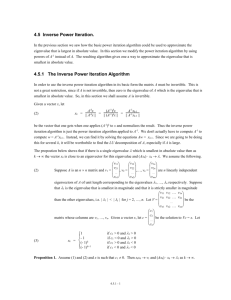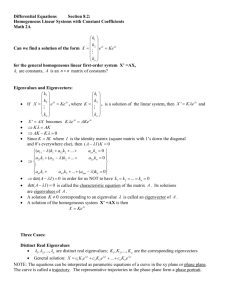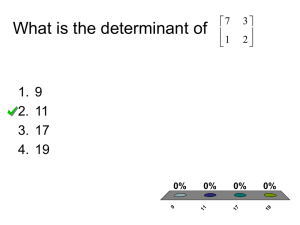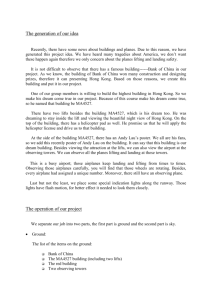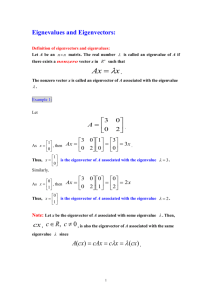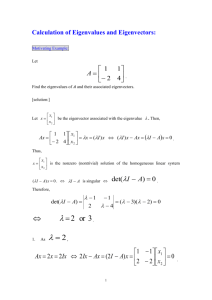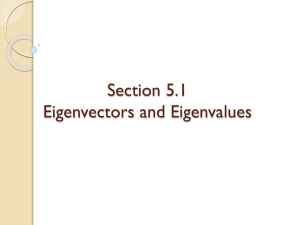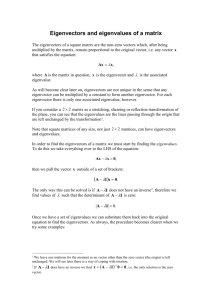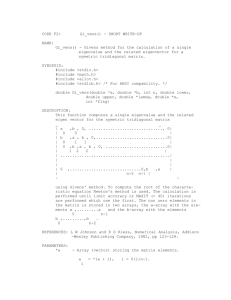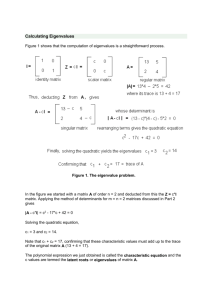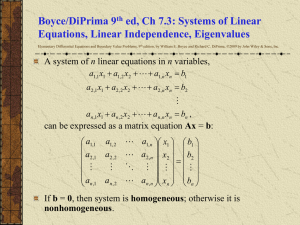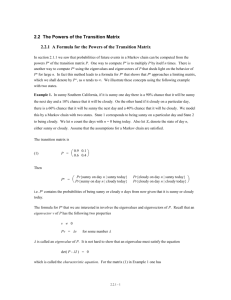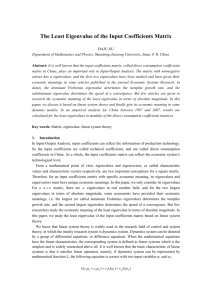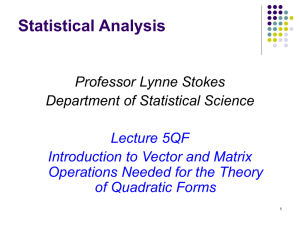Chapter13Rev1
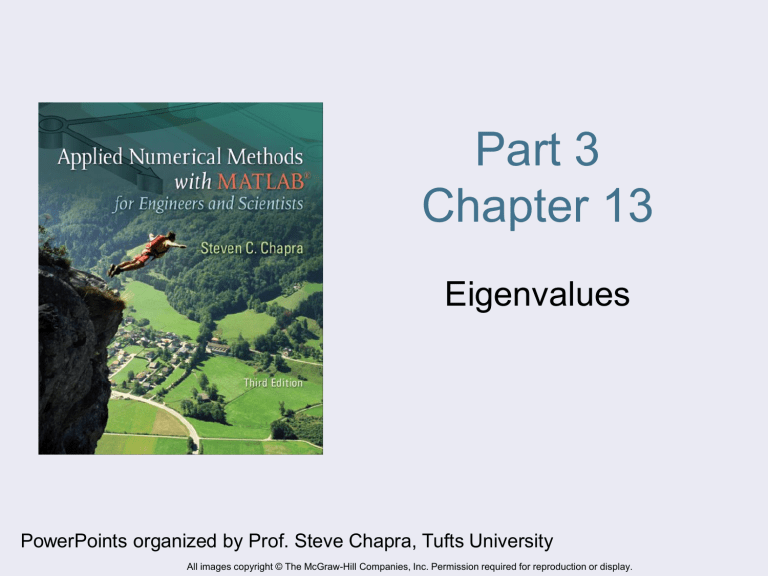
Part 3
Chapter 13
Eigenvalues
PowerPoints organized by Prof. Steve Chapra, Tufts University
All images copyright © The McGraw-Hill Companies, Inc. Permission required for reproduction or display.
Chapter Objectives
• Understanding the mathematical definition of eigenvalues and eigenvectors.
• Understanding the physical interpretation of eigenvalues and eigenvectors within the context of engineering systems that vibrate or oscillate.
• Knowing how to implement the polynomial method.
• Knowing how to implement the power method to evaluate the largest and smallest eigenvalues and their respective eigenvectors.
• Knowing how to use and interpret MATLAB’s eig function.
Dynamics of Three Coupled Bungee
Jumpers in Time
Is there an underlying pattern???
Mathematics
Up until now, heterogeneous systems:
[ A ] { x } = { b }
What about homogeneous systems:
[ A ] { x } = 0
Trivial solution:
{ x } = 0
Is there another way of formulating the system so that the solution would be meaningful???
Mathematics
What about a homogeneous system like:
( a
11
– l
) x
1 a
21 a
31 x
1 x
1
+ a
12
+ ( a
22
– x
2 l
) x
2
+ a
32 x
2
+ a
13 x
3
+ a
23
+ ( a
33
– x
3 l
) x
3
= 0
= 0
= 0 or in matrix form l [ I ]
{ x } = 0
For this case, there could be a value of l that makes the equations equal zero. This is called an eigenvalue .
Graphical Depiction of Eigenvalues
Physical Background:
Oscillations or Vibrations of Mass-
Spring Systems
Model With Force Balances
(AKA: F = ma ) m
1 m
2 d 2 x
1 dt 2 d 2 x
2 dt 2
= – k x
1
+ k ( x
2
– x
1
)
= – k ( x
2
– x
1
) – kx
2
Collect terms: m
1 m
2 d 2 x
1 dt 2 d 2 x
2 dt 2
– k
(
–
2 x
1
+ x
2
) = 0
– k
( x
1
–
2 x
2
) = 0
Assume a Sinusoidal Solution x i
= X i sin ( w t ) where w = 2p
T p
Differentiate twice: x i
”
= – X i w
2 sin ( w t )
Substitute back into system and collect terms
2 k m
1
- w 2
X
1
– k m
1
X
2
= 0 k m
2
X
1
+
2 k m
2
- w 2
X
2
= 0
Given: m
1
= m
2
(10 –
= 40 kg; k = 200 N/m w
2 ) X
1
–
– 5
X
1
+ (10 –
5 X
2 w
2 ) X
2
= 0
= 0
This is now a homogeneous system where the eigenvalue represents the square of the fundamental frequency.
Solution: The Polynomial Method
10 – w
2
-
5 X
1
– 5 10 – w
2 X
2
=
0
0
Evaluate the determinant to yield a polynomial
10 – w
2
-
5
– 5 10 – w
2
= ( w
2 ) 2
- 20 w
2
+ 75
The two roots of this "characteristic polynomial" are the system's eigenvalues: w
2 =
15
5 or w = 3.873 Hz
2.36 Hz
T p
INTERPRETATION w
2 = 5 /s 2 w
= 2.236 /s
= 2 p
/2.236 = 2.81 s T p w
2 = 15 /s 2 w
= 3.873 /s
= 2 p
/3.373 = 1.62 s
(10 – w
2 ) X
– 5
X
1
1
–
+ (10 –
5 X
2 w
2 ) X
2
= 0
= 0
(10 –
5
) X
1
– 5
X
1
–
5 X
2
+ (10 –
5
) X
2
= 0
= 0
(10 – 1
5
) X
1
– 5
X
1
–
5 X
+ (10 – 1
5
) X
2
2
= 0
= 0
5
X
1
– 5
X
1
– 5
X
2
+
5
X
2
= 0
= 0
– 5
X
1
– 5
X
1
– 5
X
2
– 5
X
2
= 0
= 0
X
1
= X
2
X
1
= – X
2
V =
–0.7071
–0.7071
V =
–0.7071
0.7071
T p
= 1.62
Principle Modes of Vibration
T p
= 2.81
The Power Method
Iterative method to compute the largest eigenvalue and its associated eigenvector.
[[ A ]
l
[ I ]]]{ x } = 0
[ A ]{ x } = l
{ x }
Simple Algorithm: function [eval, evect] = powereig(A,es,maxit) n=length(A); evect=ones(n,1);eval=1;iter=0;ea=100; %initialize while (1) evalold=eval; %save old eigenvalue value evect=A*evect; %determine eigenvector as [A]*{x) eval=max(abs(evect)); %determine new eigenvalue evect=evect./eval; %normalize eigenvector to eigenvalue iter=iter+1; if eval~=0, ea = abs((eval-evalold)/eval)*100; end if ea<=es | iter >= maxit, break , end end
Example: The Power Method
First iteration:
40
-
20 0
-
20 40
-
20
0
-
20 40
1
1
1
=
20
0
20
= 20
1
0
1
Second iteration:
40
-
20 0
-
20 40
-
20
0
-
20 40
1
0
1
=
40
-
20
40
= 40
1
-
1
1
| e a
| =
40
-
20
40
100% = 50%
Example: The Power Method
Third iteration:
40
-
20 0
-
20 40
-
20
0
-
20 40
1
-
1
1
=
60
-
80
60
=
-
80
-
0.75
1
-
0.75
| e a
| =
-
80
-
40
-
80
Fourth iteration:
100% = 150%
40
-
20 0
-
20 40
-
20
0
-
20 40
-
0.75
1
-
0.75
=
-
50
75
-
50
= 70
-
0.71429
1
-
0.71429
| e a
| =
70
- (-
80)
70
100% = 214%
Example: The Power Method
Fifth iteration:
40
-
20 0
-
20 40
-
20
0
-
20 40
-
0.71429
1
-
0.71429
=
-
48.51714
68.51714
-
48.51714
= 68.51714
-
0.71429
1
-
0.71429
| e a
| =
68.51714 70
70
100% = 2.08%
The process can be continued to determine the largest eigenvalue (= 68.284) with the associated eigenvector
[
-
0.7071 1
-
0.7071]
Note that the smallest eigenvalue and its associated eigenvector can be determined by applying the power method to the inverse of A
Determining Eigenvalues &
Eigenvectors with MATLAB
>> A = [10 -5;-5 10]
A =
10 -5
-5 10
>> [v,lambda] = eig(A) v =
-0.7071 -0.7071
-0.7071 0.7071
lambda =
5 0
0 15
Dynamics of Three Story Building
Principle Modes of Vibration

